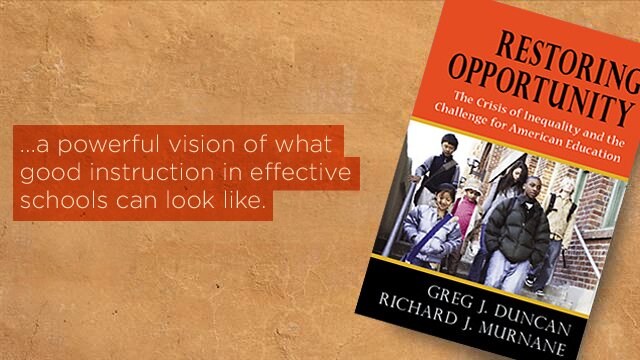Economists Greg Duncan and Richard Murnane asked us to help them transform a well-received academic book (“”—which we had edited originally) into a more approachable book that would appeal to a broader education policy audience. The result is .” The book highlights proven strategies for narrowing the achievement gap between low-income children and their more fortunate peers.
Book Manuscript
Client:

Chapter 2: Diverging Destinies
All in all, 1972 looked like a good year to graduate from high school. The Vietnam War still gripped the country, but both the war and the draft were about to end. The OPEC oil embargo was still more than a year away, and the nation was enjoying not only cheap gasoline, but also low inflation. Transistors were beginning to revolutionize computing, although in early 1972 handheld calculators often weighed two pounds and cost $200.
There was little need for high school graduates to worry if they wanted to pass up college and head directly into the labor market. The economy was recovering from a minor recession, with the unemployment rate headed below 5 percent. Even unemployment among teenagers was low. To be sure, college graduates earned more than high school grads, but their 40 percent average wage advantage was modest by historical standards and small enough that some would-be college students were no doubt convinced to change their plans. Indeed, a book published in the middle of the decade, the Overeducated American, made headlines for conclusion that the earnings payoff to higher education was declining.
The year 1972 also marked the beginning of a landmark study of high school seniors. Some 19,000 students in the study were selected at random from more than 1,000 schools. For one-third of them, high school graduation would mark the end of their formal schooling. But even their high school diplomas were an indication of the kind of intergenerational mobility that was a source of pride for most Americans; nearly one-third of the graduates had already completed more schooling than either of their parents.
Most of the male high school graduates would go on to begin promising careers. A follow-up survey conducted in 1979, when respondents were in their mid-twenties, found that more than 90 percent of the men with just a high school diploma were working full time. Most held skilled blue-collar jobs and enjoyed earnings that were close to the national average. These successes were hardly a surprise at the time, given the technology-driven productivity gains across the 1950s and 1960s had led to steep gains in the economic fortunes of both high- and low-skilled workers. Today we tend to think of technology in terms of the breathtaking advances made possible by microprocessors, nanotechnology, and biotechnology. But the broad sweep of the twentieth century included advances such as the introduction of electric power into homes and factories, assembly line production techniques, and the construction of the interstate highway system. These advances catalyzed economic growth and increased earnings opportunities for both highly educated workers and those with relatively little formal education.
